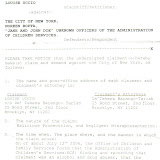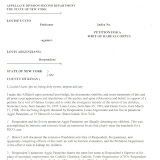Child welfare professionals are taking a hard look at why so many African American children are in care. > By Karen Loew
City Limits WEEKLY #622
There's an elephant in the living room of foster care. It's been there for quite a while. But finally, instead of pretending it isn't there, the release of a landmark federal report is prompting more people to mention it, examine it, describe it and debate it.
The subject that's largely been met with denial or silence is the disproportionately high number of African-American children in foster care nationwide compared to their numbers in the general population. Following publication of a report by the General Accounting Office, "African American Children in Foster Care:
Additional HHS Assistance Needed to Help States Reduce the Proportion in Care," child welfare professionals are discussing the reasons for disproportionateness – black children make up 15 percent of the nation's children, but 34 to 37 percent of those in foster care – and what to do about it.
"It said, straight out, there appears to be some bias in decision making," Mike Arsham, executive director of the Child Welfare Organizing Project (CWOP), said of the report. Along with U.S. Rep. Charles Rangel of Harlem, CWOP convened a forum last month to discuss the report and related issues. "There's a lot of denial ... we can't begin to come to grips with it until we own it," Arsham said. "You can't work in this field and not have it on your mind."
Rangel commissioned the GAO report in his role as chairman of the House Ways and Means Committee. At the forum in Harlem last month – which Arsham said was designed to "give the report some legs" – Rangel said that he was motivated not just by compassion, but by his Ways and Means focus on building competitiveness and increasing revenues.
"If there was a relationship between lack of education and having a child that would be given to foster care, or living in conditions that fester the causes as to why a child ends up in foster care, isn't it legitimate to ask how much does it cost to invest in this?" Rangel asked. "How much does it cost in order to prevent this from happening? How much do you have to invest in education and health so that we don't have people in our jails, so we don't have people who are not productive?"
While the report didn't name a dollar figure, it did make some clear recommendations that indicate a shift in funding at the very least. Chief among them is to amend federal law to allow subsidies for legal guardianships, so that if a family member or close friend wants to assume responsibility for a child, that guardian can receive financial aid – and without necessarily becoming part of the official foster care system.
"It's just culturally inappropriate" to require someone like a grandmother to follow all the rules and regulations that a foster parent must, says Arsham.
Following the forum, he invited attendees and others to take part in an e-mail exchange to further the dialogue and advocate specific "fiscal, regulatory, or legislative priorities for system change." From New York city and state agencies, public agencies elsewhere, advocates and lawyers, responses poured in.
"Subsidized guardianship will certainly give family members a way to go when seeking to help children in neglectful or abusive homes," wrote Rochelle Williams, a forensic social worker at the Legal Aid Society. "Many times family members call in reports because they cannot step in and care for the child because they lack the financial resources. Subsidized guardianship would help in those situations."
Attorney Tracey Bing-Hampson from Manhattan Legal Services put the same thing at the top of her 10-item list of things that would help reduce African American children's overrepresentation in foster care. After that came increased funding for hiring more judges for family court, more law guardians (attorneys for children), more attorneys that represent parents in abuse and neglect proceedings, more Administration for Children's Services (ACS) lawyers and more-experienced ACS caseworkers. Bing-Hampson also recommended funding counseling and services for young adults "aging out" of foster care, additional specialized training of ACS and agency caseworkers, expanding preventive services, and training public educators about issues facing foster care students.
(For more on kinship care and subsidized guardianship, see the new issue of Child Welfare Watch, p. 8.)
"Greater funding flexibility must be provided for prevention services. The most effective way to alter the disproportionate representation of minority children in our placement system is prevent their entering the system," wrote Julia Danzy, Philadelphia's director of social services and president of the board of Black Administrators in Child Welfare. "There also must be greater value and funding flexibility for the use of paraprofessionals in the provision of many of the prevention services ... Needless to say we need to have the ability for [federal] funding for subsidized kinship care."
Another NYC attorney, Carolyn Kubitschek, cited statistics from the state Office of Children and Family Services (OCFS). Of the 17,214 children in foster care in New York City in 2007, the breakdown was 56 percent black, 28 percent Hispanic, 4 percent white, and 11 percent other/unknown. And yet the breakdown of children receiving much sought-after preventive services in 2006, according to OCFS, was 46 percent white, 45 percent black and 8 percent unknown. "I would favor laws requiring parity – specifically, that the foster care population cannot have a higher percentage of African American children than the population of the city as a whole," Kubitschek wrote.
That drew a strong response from Marc Zappala, a research analyst at the National Council for Adoption in Alexandria, Va. Laws requiring parity would not help children, Zappala said. "There are a number of reasons why African-American children are overrepresented in foster care. In addition to differential response on the part of social workers, the African American community has higher poverty rates and much higher rates of single-mother households than the white, Hispanic and Asian communities," he wrote. "If you completely eliminated the differential responses on the part of social workers, you would still have higher percentages of African-American children in foster care because these two factors correlate with maltreatment of children."
Arsham from CWOP disagrees. In an interview, he said there are Chinese families in New York, for example, with similar finance and family situations – but "you don't see Chinese children in foster care."
"Even when you adjust for poverty, African Americans are overrepresented," he said. "It's complex. Yes, it has to do with poverty. But it also has to do with discrimination, negative assumptions and stereotypes."
With input from the e-mail discussion and otherwise, Arsham is drafting a letter for Rep. Rangel containing national priorities for reducing disproportionateness.
Meanwhile, ACS has been working on the same issues, both by aiming for application of fair and constructive standards across the board, and through its ongoing Task Force on Racial Equity and Cultural Competence. The task force "is currently formulating a plan of action, which will include further analysis of the data so that we can better understand the experiences of different cultural groups and different neighborhoods with child welfare services and interventions," ACS spokeswoman Sheila Stainback said.
The co-chairwoman of the task force, ACS Director of Preventive Family Team Conferencing Tula Lacy, jumped into the e-mail dialogue today with a suggestion about increasing funds for a variety of family advocates. Fresh from a Jan. 10 panel at the Urban Institute in Washington on "Racial Disparity in the Child Welfare System," Lacy wrote, "When families have skilled attorneys and social workers who represent them, they have a better chance of staying out of the system, or if they enter, to have shorter stays. ... In addition families need a strong professional network that can talk to judges and other attorneys, talk with social workers and other service providers in their 'professional' language to represent these families."
A child welfare bill could be introduced in Congress this year, according to Ways and Means staff – but with so many pressing aspects of foster care to address, it's not yet clear how specifically legislation will target the disproportionate nature of foster care nationwide.
But it seems like that elephant is invisible to fewer people all the time, notes Gayle Samuels, a social worker at the Center for the Study of Social Policy in Washington. Samuels is helping the state of Michigan to evaluate "the overrepresentation of children of color in their child abuse and neglect and juvenile justice systems."
"It's similar to race in America. In some circles, people talk about it all the time; in some circles, it's the elephant in the room," she said. For people ready to grapple with why there are so many African American children in foster care, "the circle is widening."
Original article-
City Limits: News for NYC's Nonprofit, Policy and Activist World
Subscribe to:
Post Comments (Atom)




















No comments:
Post a Comment